Assessment of the Temperature Effects in SMAP Satellite Soil Moisture Products in Oklahoma
Abstract
:1. Introduction
2. Study Area and Data Description
2.1. Study Area
2.2. Data Description
2.2.1. In Situ Data
- We make a comparison between the in situ and satellite data in this study. Therefore, these selected sites have to meet the conditions of the core validation sites for the SMAP level 3 soil moisture (radiometer) products (L3_SM_P), that Colliander et al. mentioned in their study [27] to adequately represent the footprint of satellite data;
- Some in situ networks restrict user access, or a public link is not available; these issues may be a limitation for further studies which would like to replicate this study. Hence, we suggest that the accessibility of in situ networks is one of the critical criteria;
- The availability of long, continuous dielectrically measured SWC along with temperature data at the same depth near the ground surface [30] is important for a better reflection of site condition. As referred from Kapilaratne and Lu’s [37] research, the duration of data has to be at least two years for analyzing the temperature correction coefficient, which will be discussed in the next section;
The Little Washita River Experimental Watershed
Fort Cobb Reservoir Experimental Watershed
2.2.2. Satellite Data
3. Methods and Results
3.1. Analyzing the Trend of ASC and DES Soil Moisture from Both Retrieval Products and In Situ Observations
3.2. Temperature Effects Removal
3.2.1. Examining the Temperature Dependency of SMAP Soil Moisture after Correction
3.2.2. Evaluating the Relationship between Satellite and In Situ Soil Water Content
3.2.3. Evaluating the Impact of Temperature on Brightness Temperature at Soil Surface
4. Discussion
5. Conclusions
Author Contributions
Funding
Institutional Review Board Statement
Informed Consent Statement
Data Availability Statement
Conflicts of Interest
References
- Entekhabi, D.; Rodriguez-Iturbe, I.; Castelli, F. Mutual interaction of soil moisture state and atmospheric processes. J. Hydrol. 1996, 184, 3–17. [Google Scholar] [CrossRef]
- Fernández-Prieto, D.; Kesselmeier, J.; Ellis, M.; Marconcini, M.; Reissell, A.; Suni, T. Earth observation for land-atmosphere interaction science. Biogeosciences 2013, 10, 261–266. [Google Scholar] [CrossRef]
- Peterson, A.M.; Helgason, W.D.; Ireson, A.M. Estimating field-scale root zone soil moisture using the cosmic-ray neutron probe. Hydrol. Earth Syst. Sci. 2016, 20, 1373–1385. [Google Scholar] [CrossRef] [Green Version]
- Larson, K.M.; Small, E.E.; Gutmann, E.; Bilich, A.; Axelrad, P.; Braun, J. Using GPS multipath to measure soil moisture fluctuations: Initial results. GPS Solut. 2008, 12, 173–177. [Google Scholar] [CrossRef]
- Crawford, T.M.; Stensrud, D.J.; Carlson, T.N.; Capehart, W.J. Using a soil hydrology model to obtain regionally averaged soil moisture values. J. Hydrometeorol. 2000, 1, 353–363. [Google Scholar] [CrossRef]
- Dobriyal, P.; Qureshi, A.; Badola, R.; Hussain, S.A. A review of the methods available for estimating soil moisture and its implications for water resource management. J. Hydrol. 2012, 458–459, 110–117. [Google Scholar] [CrossRef]
- Susha Lekshmi, S.U.; Singh, D.N.; Shojaei Baghini, M. A critical review of soil moisture measurement. Meas. J. Int. Meas. Confed. 2014, 54, 92–105. [Google Scholar] [CrossRef]
- Al-Shrafany, D.; Rico-Ramirez, M.A.; Han, D.; Bray, M. Comparative assessment of soil moisture estimation from land surface model and satellite remote sensing based on catchment water balance. Meteorol. Appl. 2014, 21, 521–534. [Google Scholar] [CrossRef]
- Larson, K.M.; Braun, J.J.; Small, E.E.; Zavorotny, V.U.; Gutmann, E.D.; Bilich, A.L. GPS Multipath and Its Relation to Near-Surface Soil Moisture Content. IEEE J. Sel. Top. Appl. Earth Obs. Remote Sens. 2010, 3, 91–99. [Google Scholar] [CrossRef]
- Petropoulos, G.P.; Ireland, G.; Barrett, B. Surface soil moisture retrievals from remote sensing: Current status, products & future trends. Phys. Chem. Earth 2015, 83–84, 36–56. [Google Scholar] [CrossRef]
- Kaihotsu, I. A review of soil moisture observation studies in the hydrological cycle in lands. J. Groundw. Hydrol. 2018, 60, 263–271. [Google Scholar] [CrossRef]
- Pang, Z.; Qin, X.; Jiang, W.; Fu, J.; Yang, K.; Lu, J.; Qu, W.; Li, L.; Li, X. The review of soil moisture multi-scale verification methods. ISPRS Ann. Photogramm. Remote Sens. Spat. Inf. Sci. 2020, 5, 395–399. [Google Scholar] [CrossRef]
- Jackson, T.J.; Schmugge, T.J. Passive Microwave Remote Sensing of Soil Moisture; Yen, B.C., Ed.; Aacademic Press, INC.: Cambridge, MA, USA, 1986; Volume 14, ISBN 9780120218141. [Google Scholar]
- Njoku, E.G.; Jackson, T.J.; Lakshmi, V.; Chan, T.K.; Nghiem, S.V. Soil moisture retrieval from AMSR-E. IEEE Trans. Geosci. Remote Sens. 2003, 41, 215–228. [Google Scholar] [CrossRef]
- Rüdiger, C.; Calvet, J.C.; Gruhier, C.; Holmes, T.R.H.; de Jeu, R.A.M.; Wagner, W. An intercomparison of ERS-Scat and AMSR-E soil moisture observations with model simulations over France. J. Hydrometeorol. 2009, 10, 431–447. [Google Scholar] [CrossRef] [Green Version]
- Kaihotsu, I.; Koike, T.; Tamagawa, K.; Ohta, T.; Fujii, H. Soil moisture observations in CEOP, GEOSS and earth observation satellite missions. J. Jpn. Soc. Soil Phys. 2009, 111, 5–8. [Google Scholar]
- Srivastava, P.K.; Pandey, V.; Suman, S.; Gupta, M.; Islam, T. Chapter 2: Available data sets and satellites for terrestrial soil moisture estimation. In Satellite Soil Moisture Retrieval: Techniques and Applications; Srivastava, P.K., Petropoulos, G.P., Kerr, Y.H., Eds.; Elsevier Inc.: Amsterdam, The Netherlands, 2016; Volume 2010, pp. 29–44. ISBN 9780128033890. [Google Scholar]
- Kerr, H.Y.; Waldteufel, P.; Wigneron, J.-P.; Delwart, S.; Cabot, F.; Boutin, J.; Escorihuela, M.-J.; Font, J.; Reul, N.; Gruhier, C.; et al. The SMOS mission: New tool for monitoring key elements of the global water cycle. Proc. IEEE 2010, 98, 666–685. [Google Scholar] [CrossRef] [Green Version]
- Entekhabi, D.; Njoku, E.G.; O’Neill, P.E.; Kellogg, K.H.; Crow, W.T.; Edelstein, W.N.; Entin, J.K.; Goodman, S.D.; Jackson, T.J.; Johnson, J.; et al. The soil moisture active passive (SMAP) mission. Proc. IEEE 2010, 98, 704–716. [Google Scholar] [CrossRef]
- Piepmeier, J.R.; Focardi, P.; Horgan, K.A.; Knuble, J.; Ehsan, N.; Lucey, J.; Brambora, C.; Brown, P.R.; Hoffman, P.J.; French, R.T.; et al. SMAP L-band microwave radiometer: Instrument design and first year on orbit. IEEE Trans. Geosci. Remote Sens. 2017, 55, 1954–1966. [Google Scholar] [CrossRef] [PubMed] [Green Version]
- Chan, S.K.; Bindlish, R.; O’Neill, P.; Jackson, T.; Njoku, E.; Dunbar, S.; Chaubell, J.; Piepmeier, J.; Yueh, S.; Entekhabi, D.; et al. Development and assessment of the SMAP enhanced passive soil moisture product. Remote Sens. Environ. 2018, 204, 931–941. [Google Scholar] [CrossRef] [Green Version]
- Crow, W.T.; Chan, S.T.K.; Entekhabi, D.; Houser, P.R.; Hsu, A.Y.; Jackson, T.J.; Njoku, E.G.; O’Neill, P.E.; Shi, J.; Zhan, X. An observing system simulation experiment for Hydros radiometer-only soil moisture products. IEEE Trans. Geosci. Remote Sens. 2005, 43, 1289–1302. [Google Scholar] [CrossRef]
- Jackson, T.J.; Cosh, M.H.; Bindlish, R.; Starks, P.J.; Bosch, D.D.; Seyfried, M.; Goodrich, D.C.; Moran, M.S.; Du, J. Validation of Advanced Microwave Scanning Radiometer soil moisture products. IEEE Trans. Geosci. Remote Sens. 2010, 48, 4256–4272. [Google Scholar] [CrossRef]
- Gruber, A.; De Lannoy, G.; Albergel, C.; Al-Yaari, A.; Brocca, L.; Calvet, J.C.; Colliander, A.; Cosh, M.; Crow, W.; Dorigo, W.; et al. Validation practices for satellite soil moisture retrievals: What are (the) errors? Remote Sens. Environ. 2020, 244, 111806. [Google Scholar] [CrossRef]
- Jackson, T.J.; Bindlish, R.; Cosh, M.H.; Zhao, T.; Starks, P.J.; Bosch, D.D.; Seyfried, M.; Moran, M.S.; Goodrich, D.C.; Kerr, Y.H.; et al. Validation of Soil Moisture and Ocean Salinity (SMOS) soil moisture over watershed networks in the U.S. IEEE Trans. Geosci. Remote Sens. 2012, 50, 1530–1543. [Google Scholar] [CrossRef] [Green Version]
- O’Neill, P.; Rajat, B.; Chan, S.; Chaubell, J.; Njoku, E.; Tom, J. Soil Moisture Active Passive (SMAP) Algorithm Theoretical Basis document L2 & L3 Radar/Radiometer Soil Moisture (Active/Passive) Data Products; California Institute of Technology: Pasadena, CA, USA, 2019. [Google Scholar]
- Colliander, A.; Jackson, T.J.; Bindlish, R.; Chan, S.; Das, N.; Kim, S.B.; Cosh, M.H.; Dunbar, R.S.; Dang, L.; Pashaian, L.; et al. Validation of SMAP surface soil moisture products with core validation sites. Remote Sens. Environ. 2017, 191, 215–231. [Google Scholar] [CrossRef]
- Wraith, J.M.; Or, D. Temperature effects on soil bulk dielectric permittivity measured by time domain refiectometry: Experimental evidence and hypothesis development. Water Resour. Res. 1999, 35, 361–369. [Google Scholar] [CrossRef]
- Kapilaratne, R.G.C.J.; Lu, M. Evaluation of Evaporation Related Diurnal Change from Dielectrically Measured Soil Moisture. J. Water Resour. Hydraul. Eng. 2017, 6, 43–50. [Google Scholar] [CrossRef]
- Lu, M.; Kapilaratne, J.; Kaihotsu, I. A data-driven method to remove temperature effects in TDR-measured soil water content at a Mongolian site. Hydrol. Res. Lett. 2015, 9, 8–13. [Google Scholar] [CrossRef] [Green Version]
- Saito, T.; Fujimaki, H.; Yasuda, H.; Inosako, K.; Inoue, M. Calibration of Temperature Effect on Dielectric Probes Using Time Series Field Data. Vadose Zo. J. 2013, 12, 1–6. [Google Scholar] [CrossRef]
- Halbertsma, J.; Van den Elsen, E.; Bohl, H.; Skierucha, W. Temperature effects in soil water content determined with time domain reflectometry. Zesz. Probl. Postep. Nauk Rol.—Pol. Akad. Nauk 1996, 436, 65–74. [Google Scholar]
- Schanz, T.; Baille, W.; Nguyen, T.L. Effects of temperature on measurements of soil water content with time domain reflectometry. Geotech. Test. J. 2011, 34, 1–8. [Google Scholar]
- André, C.; Raju, S.; Wigneron, J. Estimation of soil microwave effective temperature at L and C bands. IEEE Trans. Geosci. Remote. Sens. 1997, 35, 570–580. [Google Scholar]
- Wigneron, J.P.; Chanzy, A.; De Rosnay, P.; Rüdiger, C.; Calvet, J.C. Estimating the effective soil temperature at L-band as a function of soil properties. IEEE Trans. Geosci. Remote Sens. 2008, 46, 797–807. [Google Scholar] [CrossRef]
- Kaihotsu, I.; Asanuma, J.; Aida, K.; Oyunbaatar, D. Evaluation of the AMSR2 L2 soil moisture product of JAXA on the Mongolian Plateau over seven years (2012–2018). SN Appl. Sci. 2019, 1, 1477. [Google Scholar] [CrossRef] [Green Version]
- Kapilaratne, R.G.C.J.; Lu, M. Automated general temperature correction method for dielectric soil moisture sensors. J. Hydrol. 2017, 551, 203–216. [Google Scholar] [CrossRef]
- O’Neill, P.; Chan, S.; Bindlish, R.; Chaubell, M.; Colliander, A.; Chen, F.; Dunbar, S.; Jackson, T.J.; Piepmeier, J.; Misra, S.; et al. Calibration and Validation for the L2/3_SM_P Version 6 and L2/3_SM_P_E Version 3 Data Products; California Institute of Technology: Pasadena, CA, USA, 2019; pp. 1–44. [Google Scholar]
- Peel, M.C.; Finlayson, B.L.; McMahon, T.A. Updated world map of the Köppen-Geiger climate classification. Hydrol. Earth Syst. Sci. 2007, 11, 1633–1644. [Google Scholar] [CrossRef] [Green Version]
- Cosh, M.H.; Jackson, T.J.; Starks, P.; Heathman, G. Temporal stability of surface soil moisture in the Little Washita River watershed and its applications in satellite soil moisture product validation. J. Hydrol. 2006, 323, 168–177. [Google Scholar] [CrossRef]
- Cosh, M.H.; Starks, P.J.; Guzman, J.A.; Moriasi, D.N. Upper Washita River Experimental Watersheds: Multiyear Stability of Soil Water Content Profiles. J. Environ. Qual. 2014, 43, 1328–1333. [Google Scholar] [CrossRef]
- Brodzik, M.J.; Billingsley, B.; Haran, T.; Raup, B.; Savoie, M.H. EASE-Grid 2.0: Incremental but significant improvements for earth-gridded data sets. ISPRS Int. J. Geo-Inf. 2012, 1, 32–45. [Google Scholar] [CrossRef] [Green Version]
- Ya Kudryashova, S.; Chumbaev, A.S.; Kurbatskaya, S.S.; Kurbatskaya, S.G. Effect of soil temperature field heterogeneity on soil and vegetation spatial heterogeneity along tundra-steppe catenas in the Mongun-Taiga Mountain. IOP Conf. Ser. Earth Environ. Sci. 2019, 232, 012004. [Google Scholar] [CrossRef]
- Atchley, A.L.; Maxwell, R.M. Influences of subsurface heterogeneity and vegetation cover on soil moisture, surface temperature and evapotranspiration at hillslope scales. Hydrogeol. J. 2011, 19, 289–305. [Google Scholar] [CrossRef]
- Dorigo, W.A.; Xaver, A.; Vreugdenhil, M.; Gruber, A.; Hegyiová, A.; Sanchis-Dufau, A.D.; Zamojski, D.; Cordes, C.; Wagner, W.; Drusch, M. Global automated quality control of in situ soil moisture data from the International Soil Moisture Network. Vadose Zo. J. 2013, 12, 1–21. [Google Scholar] [CrossRef]
- Illston, B.G.; Basara, J.B.; Fisher, D.K.; Elliott, R.; Fiebrich, C.A.; Crawford, K.C.; Humes, K.; Hunt, E. Mesoscale monitoring of soil moisture across a statewide network. J. Atmos. Ocean. Technol. 2008, 25, 167–182. [Google Scholar] [CrossRef]
- Starks, P.J.; Fiebrich, C.A.; Grimsley, D.L.; Garbrecht, J.D.; Steiner, J.L.; Guzman, J.A.; Moriasi, D.N. Upper Washita River Experimental Watersheds: Meteorologic and soil climate measurement networks. J. Environ. Qual. 2014, 43, 1239–1249. [Google Scholar] [CrossRef] [PubMed]
- Mironov, V.L.; Dobson, M.C.; Kaupp, V.H.; Komarov, S.A.; Kleshchenko, V.N. Generalized refractive mixing dielectric model for moist soils. IEEE Trans. Geosci. Remote Sens. 2004, 42, 773–785. [Google Scholar] [CrossRef]
- Mironov, V.; Kerr, Y.; Wigneron, J.P.; Kosolapova, L.; Demontoux, F. Temperature-and texture-dependent dielectric model for moist soils at 1.4 GHz. IEEE Geosci. Remote Sens. Lett. 2013, 10, 419–423. [Google Scholar] [CrossRef] [Green Version]
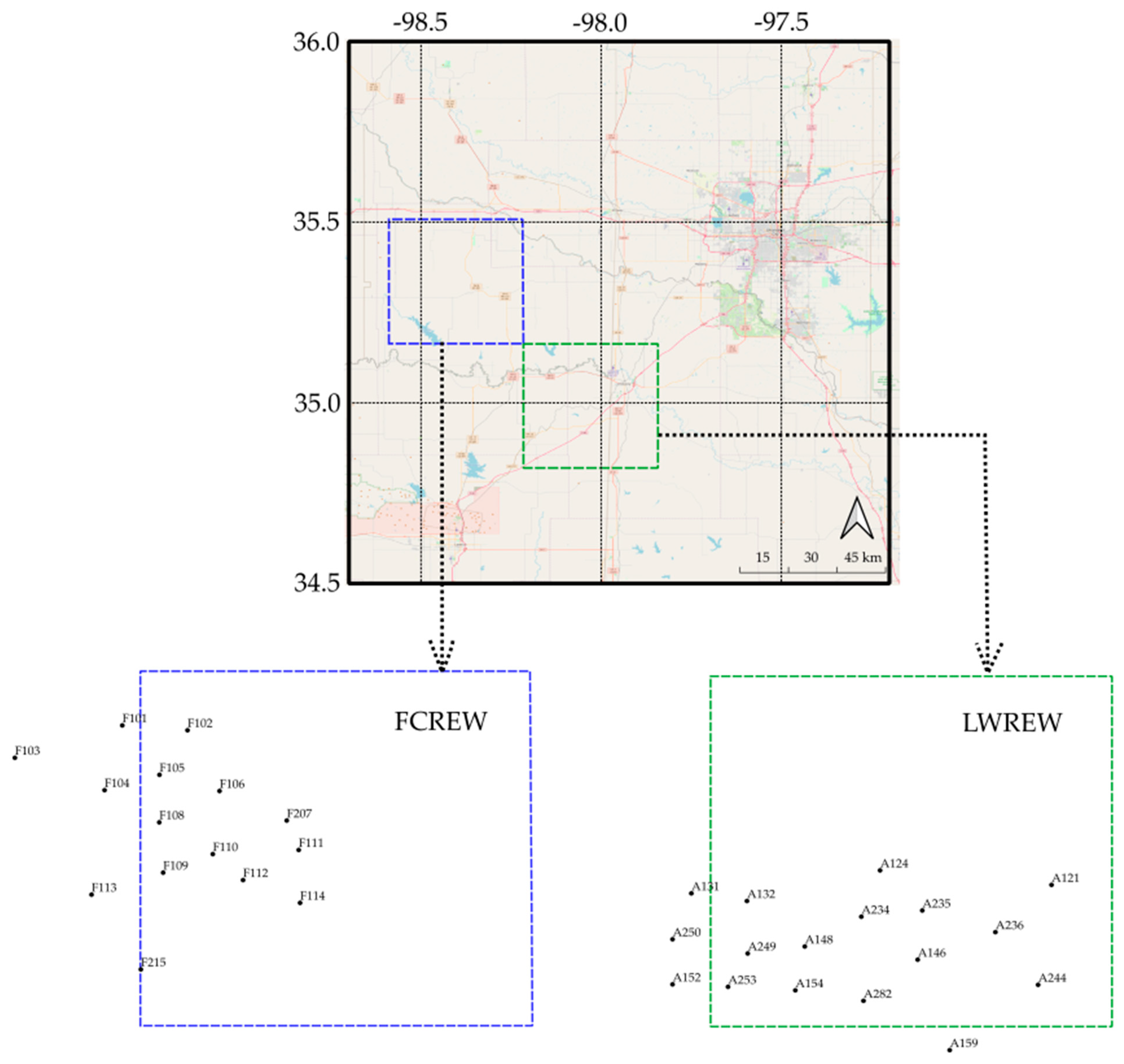

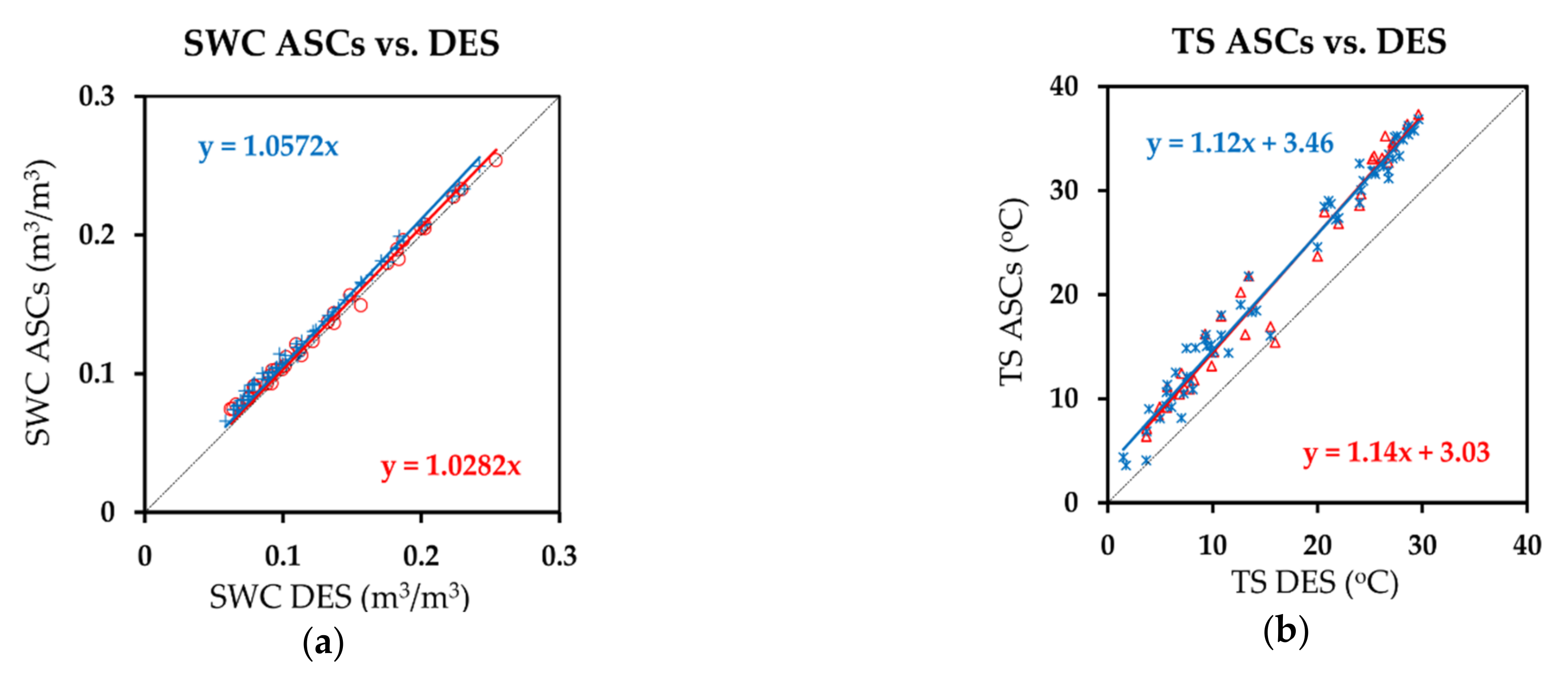
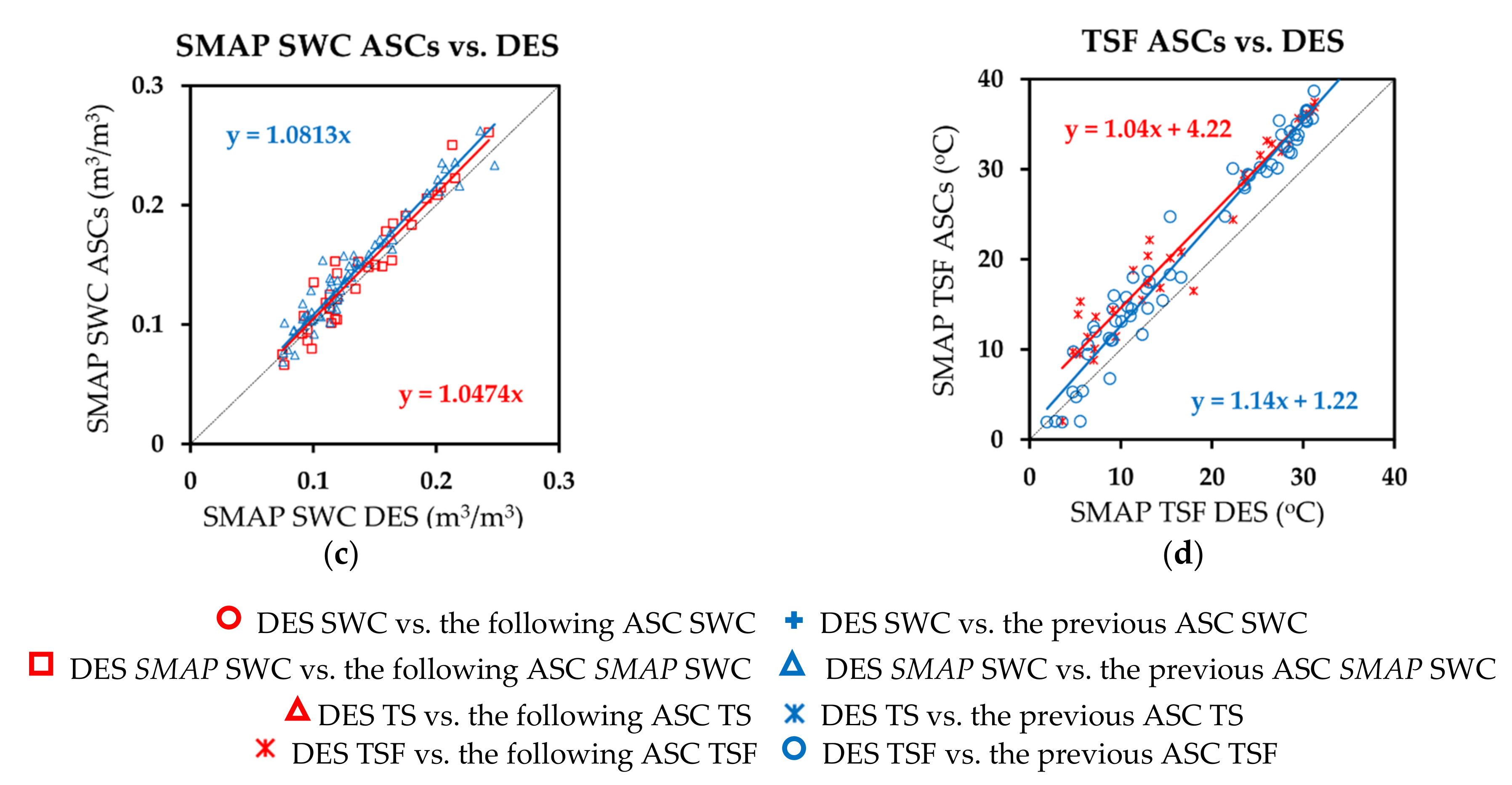
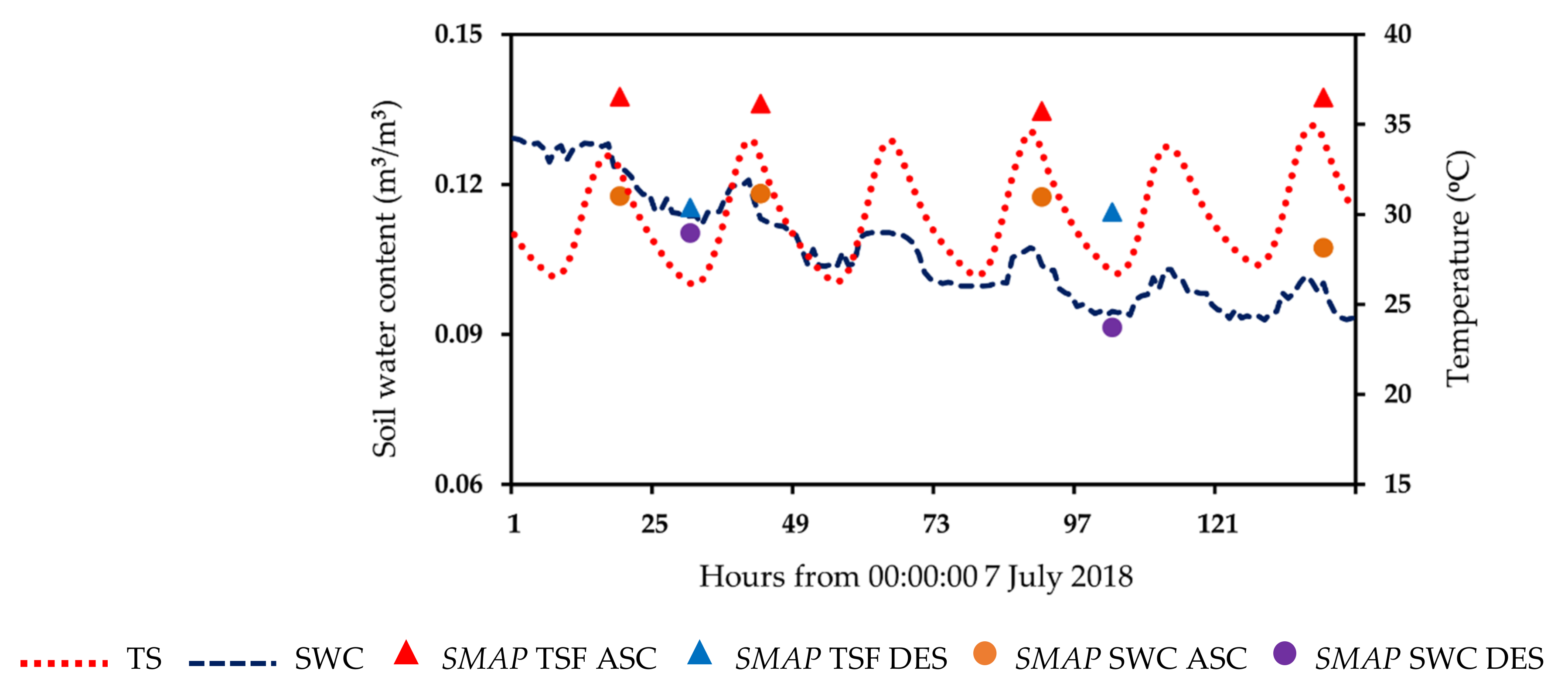

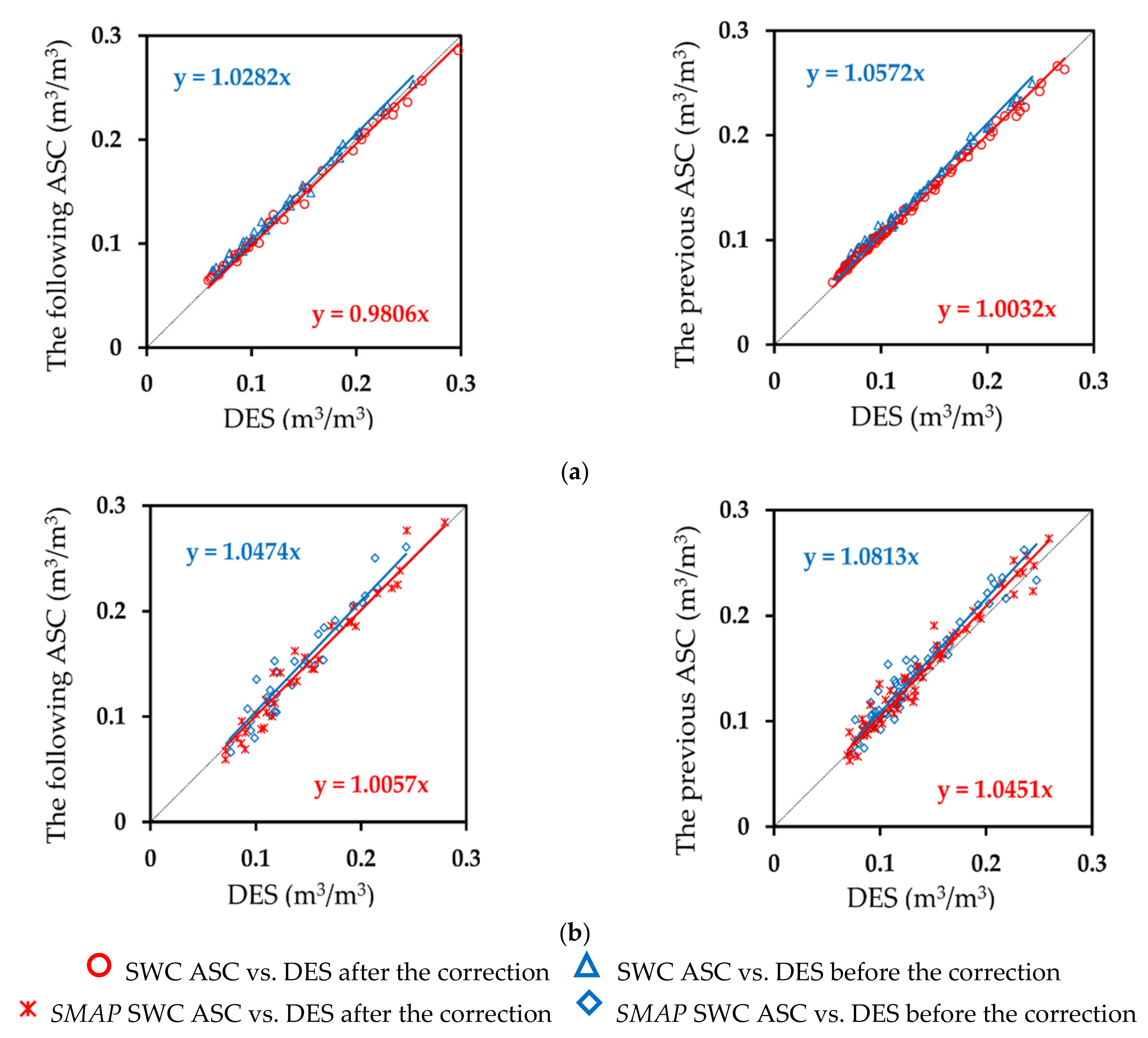
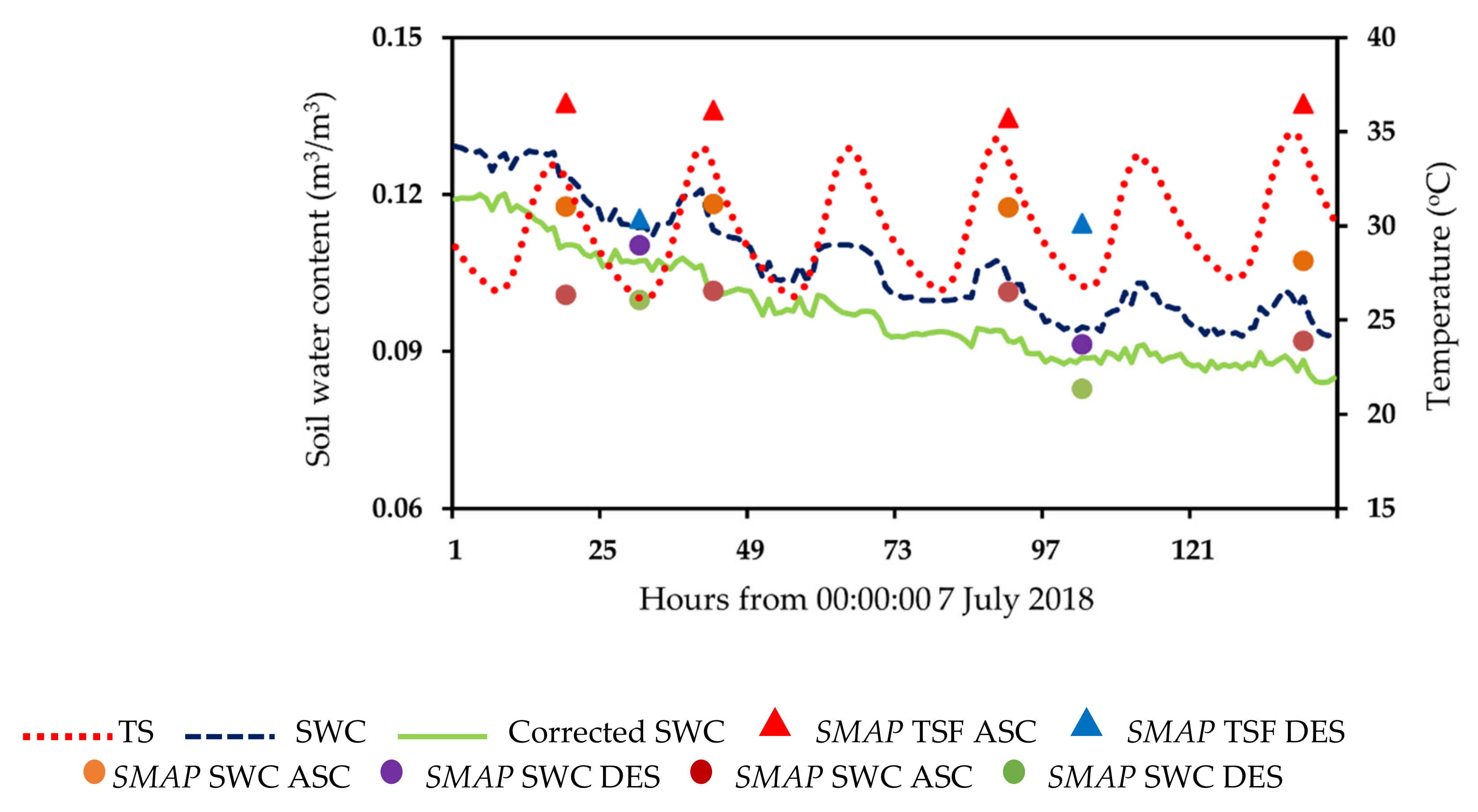
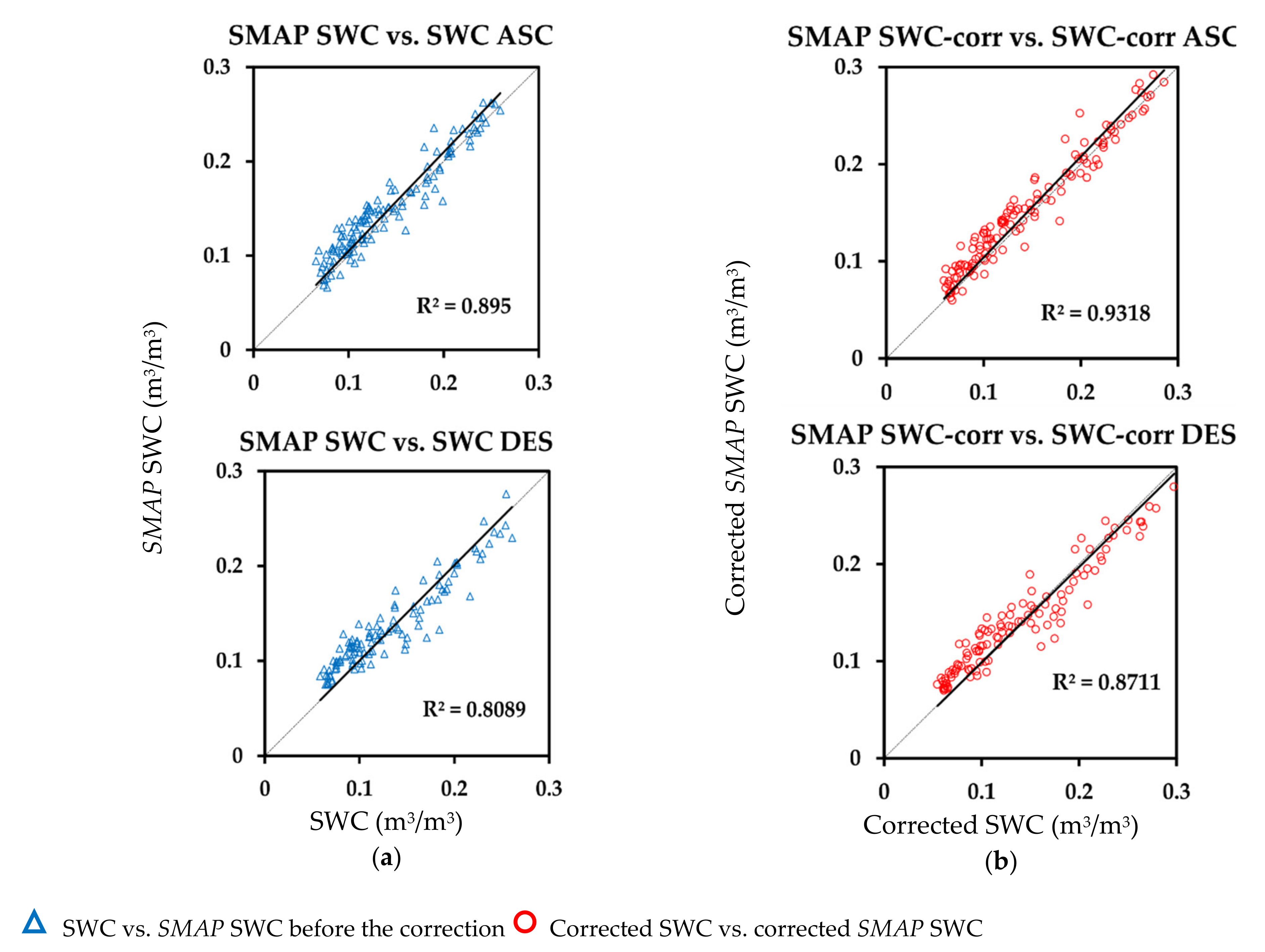

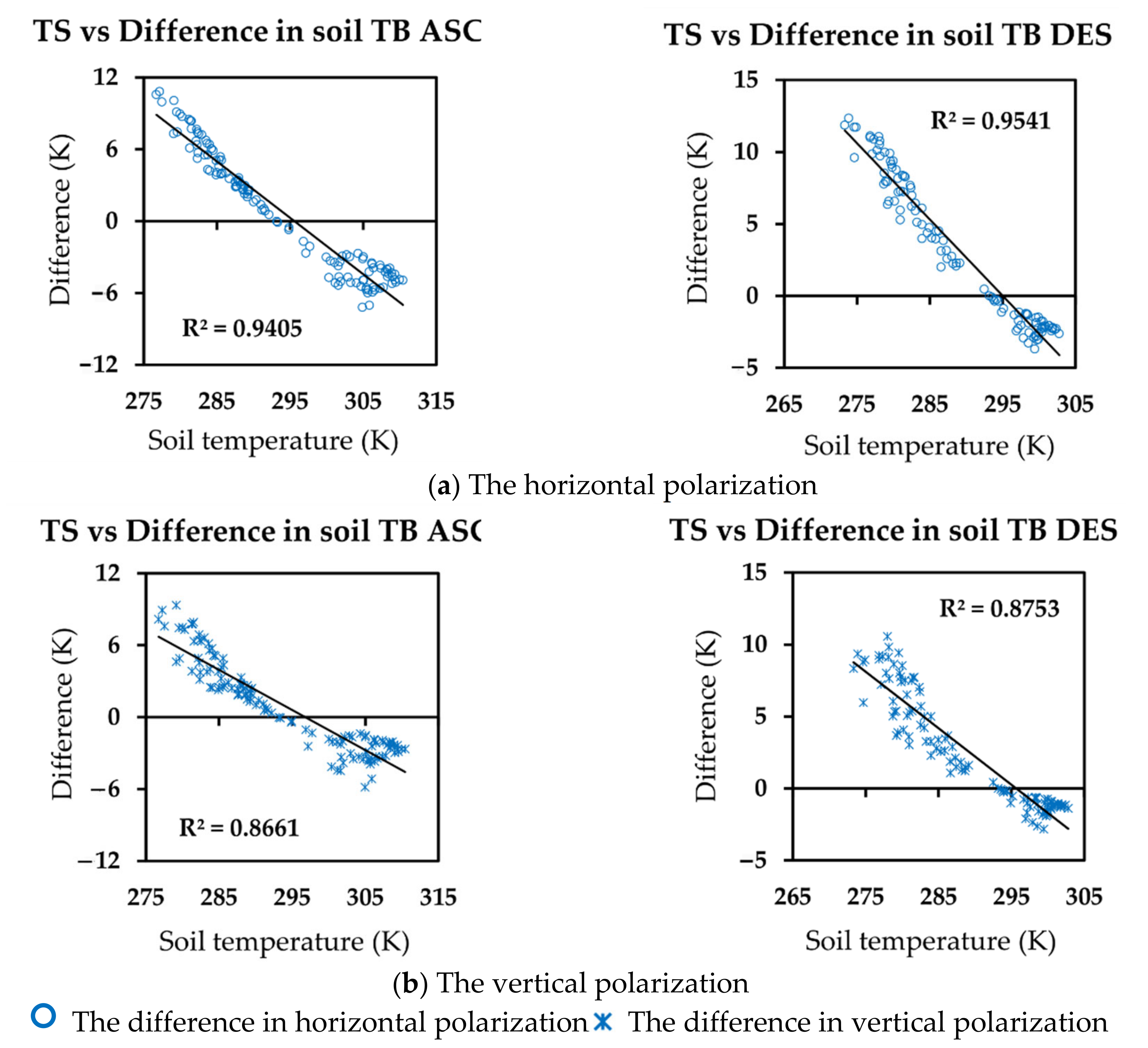
| CVS Name | Elevation (m) | Pixel (Y/X) | Climate Classification | Annual Rainfall (mm) | Landcover |
|---|---|---|---|---|---|
| LWREW [23,40] | 300–500 | 86/219 | Cfa | 760 | Grassland |
| FCREW [41] | 383–565 | 85/218 | Cfa | 816 | Grassland/cropland |
| CVS Name | The Sensors of Soil Moisture | Measurement Depth (cm) | Period | Number of Stations | Standard Deviation of the Average Values |
|---|---|---|---|---|---|
| LWREW | HydraProbe Digital Sdi-12 (2.5 volts) | 5–5 | September 2017–December 2019 | 16 | 0.0187 |
| FCREW | HydraProbe Digital Sdi-12 (2.5 volts) | 5–5 | October 2016–December 2019 | 12 | 0.0186 |
| CVS Name | (°C−1) | SWC vs. SMAP SWC (R2) | Corrected SWC vs. Corrected SMAP SWC (R2) | %Change | |||
|---|---|---|---|---|---|---|---|
| ASC | DES | ASC | DES | ASC | DES | ||
| LWREW | 0.0096 | 0.8950 | 0.8089 | 0.9318 | 0.8711 | 4.11 | 8.64 |
| FCREW | 0.0088 | 0.8016 | 0.7275 | 0.8571 | 0.8103 | 6.92 | 11.38 |
| Sites/Polarization | (°C−1) | Ascending (R2) | Descending (R2) | |||||
|---|---|---|---|---|---|---|---|---|
| Before Correction | After Correction | %Change | Before Correction | After Correction | %Change | |||
| LWREW | H V | 0.0096 | 0.9225 0.9419 | 0.9581 0.9636 | 3.86 2.30 | 0.8835 0.9092 | 0.9327 0.9408 | 5.57 3.48 |
| FCREW | H V | 0.0088 | 0.8796 0.9161 | 0.8994 0.9320 | 2.25 1.74 | 0.8531 0.9033 | 0.8866 0.9252 | 3.93 2.42 |
| Sites/Polarization | (°C−1) | Absolute Changes in ASC (K) | Absolute Changes in DES (K) | |||
|---|---|---|---|---|---|---|
| Minimum Change | Maximum Change | Minimum Change | Maximum Change | |||
| LWREW | H V | 0.0096 | 0.03 0.02 | 10.79 9.33 | 0.01 0.01 | 12.32 10.56 |
| FCREW | H V | 0.0088 | 0.00 0.00 | 10.76 9.56 | 0.05 0.04 | 11.2 9.3 |
Publisher’s Note: MDPI stays neutral with regard to jurisdictional claims in published maps and institutional affiliations. |
© 2021 by the authors. Licensee MDPI, Basel, Switzerland. This article is an open access article distributed under the terms and conditions of the Creative Commons Attribution (CC BY) license (https://creativecommons.org/licenses/by/4.0/).
Share and Cite
Hoang, K.O.; Lu, M. Assessment of the Temperature Effects in SMAP Satellite Soil Moisture Products in Oklahoma. Remote Sens. 2021, 13, 4104. https://doi.org/10.3390/rs13204104
Hoang KO, Lu M. Assessment of the Temperature Effects in SMAP Satellite Soil Moisture Products in Oklahoma. Remote Sensing. 2021; 13(20):4104. https://doi.org/10.3390/rs13204104
Chicago/Turabian StyleHoang, Kim Oanh, and Minjiao Lu. 2021. "Assessment of the Temperature Effects in SMAP Satellite Soil Moisture Products in Oklahoma" Remote Sensing 13, no. 20: 4104. https://doi.org/10.3390/rs13204104







